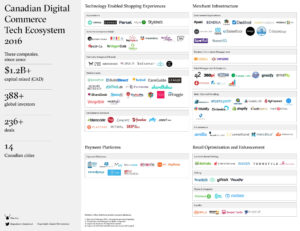2016 Digital Commerce Ecosystem Map
The following analysis was originally published in Canadian Business magazine.

Canada hasn’t had the best reputation when it comes to innovating in digital commerce. Over the past few years, Canadian businesses have been slow to adopt the technologies necessary to keep up with the growing appetite among Canadian consumers for purchasing products and services online.
In 2013—the most recent year for which Statistics Canada completed a study on digital technology and Internet use in the country—just 13% of Canadian businesses were selling online.
Meanwhile, Canadian consumers have been shopping up a storm online. Forrester Research Inc. projects that 10% of all Canadian retail spending in 2019 will be conducted online, up from 6% in 2014 and almost equivalent to—on a percentage basis—the 11% forecasted for the U.S. market. To put these numbers in perspective, Canadian retail sales totalled $505 billion in 2014, as reported by Statistics Canada. With numbers like these, the stakes are high and Canadian business are being forced to do a better job of supporting web-based commercial transactions.
Fortunately for them, an army of technology companies across the country are equipped with the technical know-how and financial support necessary to usher in a new era of digital commerce in the country, as highlighted by the infographic below. These businesses have built next-generation, software-driven platforms that are reimagining how consumers shop for products and services, while allowing merchants to enhance productivity, grow sales, and reduce operating costs over time.
The companies highlighted in the infographic are represented under four main categories:
1. Technology Enabled Shopping Experiences
This category consists of companies that are customer facing and provide shoppers with a new way to discover a product, service, or experience. On-demand service providers such as Ritual and JOIST Home are making it easy for people to skip lines at quick service restaurants, or find the right home improvement professional contractor. For individuals seeking a digital marketplace for bus tickets or a new personal fitness trainer, look no further than Busbud and LEAGUE. There are also vertically integrated and direct-to-consumer brands such as Frank & Oak and BRIKA, which have introduced customers to specially curated merchandise for new and emerging retail categories—whether it’s on a monthly subscription basis, or through an immersive in-store retail experience. Last but not least, a neat group of applications are letting users engage in interesting activities like keeping track of sales for items they have their eyes on, or pinpointing the fashion merchandise they see on their favourite TV show.
2. Merchant Infrastructure
A number of companies are empowering retailers to introduce a shopping experience that corresponds to the tastes of an increasingly digital customer base. For starters, white-labelled e-commerce solution providers like LemonStand and BlackSquare let a wide range of merchants set up online storefronts at a fraction of the time and cost required by traditional IT channels. Then there are multi-channel retailing solutions such as Shopify and TouchBistro, which are powering commerce across the omni-channel in a variety of retail sub-verticals. Companies that manage data, analytics, or product information on behalf of retailers—like Canopy Labs and Hubba—have developed powerful platforms that can map a customer’s journey, recommend the right products to them, or ensure the accuracy of the digital content they see as part of the shopping experience. Finally, a diverse range of merchant enablement applications let retailers automate or streamline an existing process or resource, helping them to boost the efficacy of their internal resources while maximizing sales along the way.
3. Retail Optimization and Enhancement
Companies belonging to this category are building technologies that help consumers shop more intelligently and purposefully, while giving retailers the opportunity to understand buyer behaviour for the sake of developing long-lasting customer relationships. An important player in this category, Aislelabs, is helping retailers track and understand data as it relates to in-store shopping activity. Other companies like Vouchr and Flipp have introduced an innovative approach to gifting or have completely redefined the weekly flyer and couponing experience. There are also white-label solution providers like Sweet Tooth that make it possible for any retailer to deliver a targeted loyalty experience to its customers.
4. Payment Processing Platforms
A wide variety of technology businesses are currently focused on streamlining financial transactions, for both merchants and consumers. As an example, Tab Payments makes it seamless to split and pay for the bill at a restaurant, while Digital Retail Apps is providing retailers with the tools to accept payments digitally, more securely, and in a less capital intensive manner.
Suffice it to say, many companies can easily belong to more than one category depending on their product and business strategy.
Although the list of companies noted here is not exhaustive, it is interesting to note that since 2010 they have collectively raised well over $1 billion in capital with the help of 388 investors globally. This was done through 236 deals across 14 cities. These are big numbers, and clearly represent the enthusiasm and capabilities Canada has quickly developed to drive innovation in digital commerce forward.
Have any questions or thoughts on these maps?
Looking to be included? Get in touch.